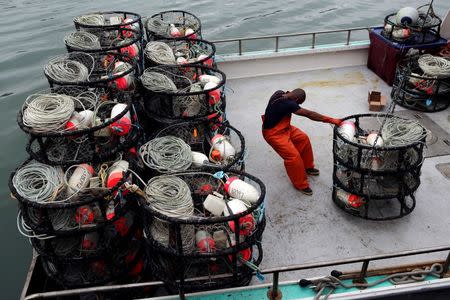Crab traps pose growing threat to whales along U.S. West Coast
By Steve Gorman LOS ANGELES (Reuters) - A blue whale found tangled in plastic rope off California has become a symbol for a little-known but growing hazard faced by the ocean's largest creatures along the U.S. Pacific Coast - commercial crab traps dotting the sea floor and drifting astray by the thousands. Scores of entanglements in crabbing gear, which constrict and can ultimately kill marine mammals, have been reported up and down the West Coast over the past few years, posing a new risk to whale populations that have been on the rebound. Humpback whales, an endangered species, and gray whales are the most frequent victims. A high-profile entanglement and rescue attempt on Monday off Southern California's Dana Point involved a blue whale, also endangered. Traps called crab pots, used in fishing for Dungeness crab, a popular seafood delicacy, are often the culprit. Wildlife officials, conservationists and scientists cite several possible factors for the trend, including a recent warming of ocean currents that may have altered whale migration and feeding patterns, putting them in closer proximity to crabbing operations. But experts also point to the mounting numbers of stray traps abandoned or torn loose by rough weather and boat traffic over the years, and the lack of a comprehensive, year-round program aimed at retrieving lost gear at sea. "It's a cumulative problem that creates an obstacle course for whales that only gets more cluttered year by year," said Steve Jones, a spokesman for the Center for Biological Diversity, an environmental group. There is little solid data to quantify the number of these roving, underwater hazards. The Pacific Fishery Management Council in 2013 reported that as many as 400,000 Dungeness crab pots are set annually from central California to the Canadian border, and that 10 percent, or 40,000, may be lost each year. Jones' group estimated that more than 8,800 crab pots went missing in California waters alone during the 2013-2014 season, based on applications the state Department of Fish and Wildlife received for replacement permits that year. RETRIEVING THE STRAYS By comparison, several hundred derelict traps were collected during a pilot recovery program last year in California that paid fishermen a bounty for abandoned gear. That program would be expanded under a bill moving through the state legislature. Rogue, lost traps are not the only problem, according to the National Oceanic and Atmospheric Administration (NOAA). The 80-foot (24-meter) blue whale that rescuers tried to free earlier this week was ensnared in the harness of a Dungeness crab pot believed to have been in active use when the whale snagged it near California's Morro Bay, NOAA spokesman Michael Milstein said. That animal was only the second blue whale - the world's largest living creature - known to have become entangled, and the 40th whale ensnared so far this year. Last year, 61 whales off the West Coast were reported caught up in polyethylene lines attached to crab traps, nearly twice as many as in 2014 and well above the five to 10 per year tallied during the two previous decades, Milstein said. Commercial watermen, hit last year by a toxic algae bloom that shortened the crabbing season, have been working with fisheries managers to address the entanglement issue. Hugh Link, executive director of the Oregon Dungeness Crab Commission, said fishermen are considering technology upgrades to improve whale safety, but equipment now in use has essentially been the same "through the generations." "Nobody wants to accidentally tangle up a whale," Link told Reuters. "We want to catch crab not anything else." (Additional reporting by Eric M. Johnson in Seattle; Editing by Ben Klayman and Sandra Maler)


